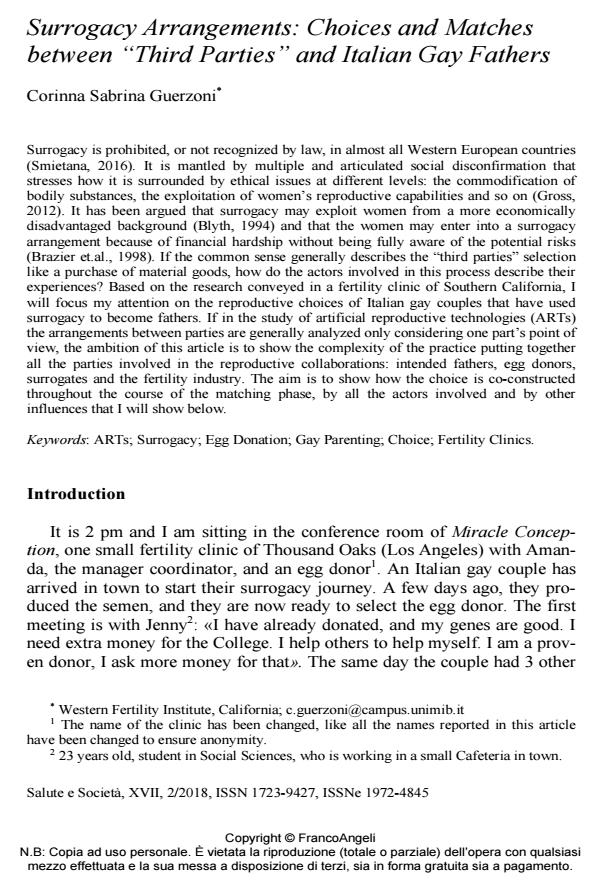Surrogacy Arrangements: Choices and Matches between "Third Parties" and Italian Gay Fathers
Journal title SALUTE E SOCIETÀ
Author/s Corinna Sabrina Guerzoni
Publishing Year 2018 Issue 2018/2
Language English Pages 13 P. 106-118 File size 66 KB
DOI 10.3280/SES2018-002008
DOI is like a bar code for intellectual property: to have more infomation
click here
Below, you can see the article first page
If you want to buy this article in PDF format, you can do it, following the instructions to buy download credits

FrancoAngeli is member of Publishers International Linking Association, Inc (PILA), a not-for-profit association which run the CrossRef service enabling links to and from online scholarly content.
Surrogacy is prohibited, or not recognized by law, in almost all Western European countries (Smietana, 2016). It is mantled by multiple and articulated social disconfirmation that stresses how it is surrounded by ethical issues at different levels: the commodification of bodily substances, the exploitation of women’s reproductive capabilities and so on (Gross, 2012). It has been argued that surrogacy may exploit women from a more economically disadvantaged background (Blyth, 1994) and that the women may enter into a surrogacy arrangement because of financial hardship without being fully aware of the potential risks (Brazier et.al., 1998). If the common sense generally describes the "third parties" selection like a purchase of material goods, how do the actors involved in this process describe their experiences? Based on the research conveyed in a fertility clinic of Southern California, I will focus my attention on the reproductive choices of Italian gay couples that have used surrogacy to become fathers. If in the study of artificial reproductive technologies (ARTs) the arrangements between parties are generally analyzed only considering one part’s point of view, the ambition of this article is to show the complexity of the practice putting together all the parties involved in the reproductive collaborations: intended fathers, egg donors, surrogates and the fertility industry. The aim is to show how the choice is co-constructed throughout the course of the matching phase, by all the actors involved and by other influences that I will show below.
Keywords: ARTs; Surrogacy; Egg Donation; Gay Parenting; Choice; Fertility Clinics.
- Does love make a family? The politics and micro-politics of filiation among same-sex families Alice Sophie Sarcinelli, in L'Année sociologique /2018 pp.367
DOI: 10.3917/anso.182.0367
Corinna Sabrina Guerzoni, Surrogacy Arrangements: Choices and Matches between "Third Parties" and Italian Gay Fathers in "SALUTE E SOCIETÀ" 2/2018, pp 106-118, DOI: 10.3280/SES2018-002008